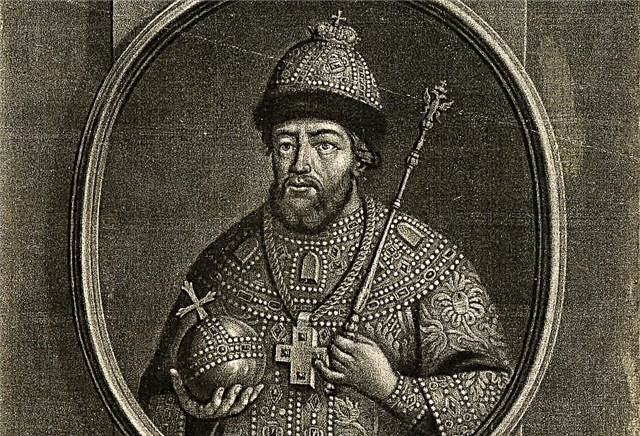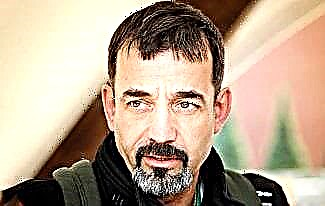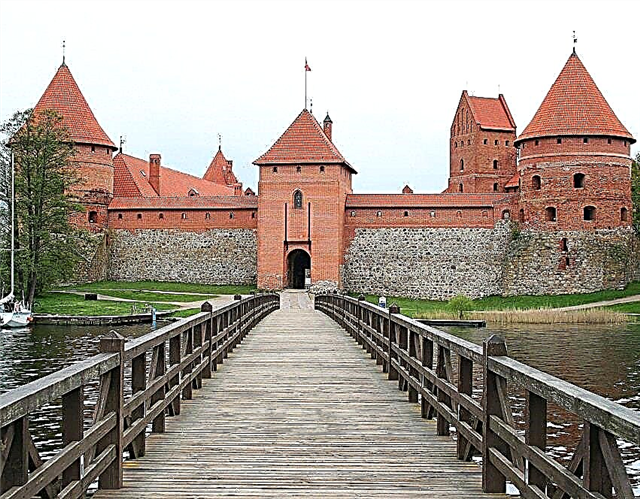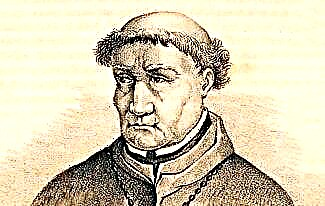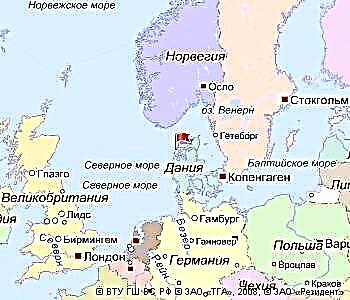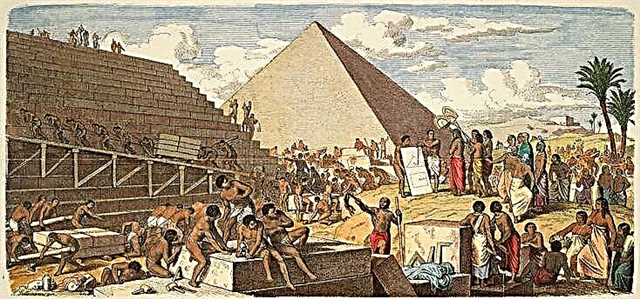The city of Samara was founded in 1586 as a fortification in a strategically important bend of the Volga at the confluence of the Samara River. Quite quickly, the fortress lost its military-strategic importance, as the line of confrontation between the Russians and the nomads rolled back to the east and south.

Model of the Samara Fortress
However, Samara did not decay, like most similar fortresses on the old borders of Russia. The city became a place of lively trade, and its status was gradually raised from a state-of-the-art to the capital of the Samara province. In Samara, a land route from west to east and a waterway from north to south intersected. After the construction of the Orenburg railway, the development of Samara became explosive.

Gradually, the city, located about 1,000 kilometers from Moscow, turned from a commercial city into an industrial center. Dozens of large industrial enterprises operate in Samara today. The city is also considered an educational and cultural center.
From 1935 to 1991, Samara was called Kuibyshev in honor of a prominent figure in the Bolshevik Party.
The population of Samara is 1.16 million people, which is the ninth indicator in Russia. The most popular information about the city: the railway station is the highest, and Kuibyshev Square is the largest in Europe. However, not only sizes are interesting in the history and modernity of Samara.

1. One of the symbols of Samara is Zhiguli beer. In 1881, an Austrian entrepreneur Alfred von Wakano opened a brewery in Samara. Von Wakano knew a lot not only about beer, but also about the equipment for its production - he worked at breweries in Austria and the Czech Republic, and successfully traded beer equipment in Russia. Beer from the Samara plant was immediately appreciated, and production began to grow by leaps and bounds. In those years, “Zhigulevskoye” meant “produced at a plant in Samara”. The beer of the same name was created already in the 1930s at the direction of Anastas Mikoyan, a party leader who did a lot for the development of the food industry in the USSR. In essence, Mikoyan asked for a little improvement on one of the beers produced at the Zhiguli Brewery. The variety with a wort density of 11% and a mass fraction of alcohol of 2.8% became the best Soviet beer. It was produced in hundreds of breweries across the country. But the authentic Zhigulevskoye, of course, is produced only at the plant in Samara. You can buy it in a store near the factory entrance, or you can taste it during a tour of the factory, which costs 800 rubles.

Alfred von Wakano - perhaps one of the most outstanding Samara residents
2. In some old houses, still standing in the center of Samara, there is still no centralized water supply. People collect water from standpipes. There is a suspicion that in other parts of the city a couple of generations of Samara residents do not know what it is. But the centralized water supply for individual houses and hotels in Samara appeared in Samara back in 1887. According to the original project of the Moscow engineer Nikolai Zimin, a pumping station was built and the first kilometers of a water pipeline were laid. The Samara water supply system also performed a fire-fighting function - fires were the scourge of wooden Samara. Entrepreneurs calculated that by “saving” real estate - saving it from fires - the water supply system paid off within a year of operation. In addition, the water supply fed 10 city fountains and was used for watering the city gardens. The most interesting thing is that the water supply was formally completely free: according to the then laws, local authorities had the right to simply increase the property tax a little for this purpose. The situation with the sewerage system was worse. Even the pressure of the owner of the Zhiguli brewery, Alfred von Wakano, who was well-respected in Samara, who was ready to fork out, acted weakly. Only in 1912 the construction of the sewerage system began. It was put into operation in parts and by 1918 they managed to lay 35 kilometers of collectors and pipes.

3. The rapid development of Samara in the 19th century attracted people to the city, regardless of nationality. Gradually, a rather serious Catholic community was formed in the city. The building permit was obtained quickly, and the builders began to build a Catholic church. But then in 1863 another uprising broke out in Poland. The bulk of the Samara Poles were sent to much more severe lands, and the construction of a church was forbidden. Construction resumed only at the beginning of the twentieth century. The church was consecrated in 1906. It survived the socio-political upheavals of the revolutions and the Civil War, but service in it lasted only until the mid-1920s. Then the church was closed. In 1941, the Samara Museum of Local Lore moved to it. Catholic services only resumed in 1996. Thus, out of more than 100 years of its history, the building of the Temple of the Sacred Heart of Jesus was used for its intended purpose only for about 40 years.

4. In the second half of the 19th century, the Samara elite gradually developed an interest in education and enlightenment. If in 1852 the merchants, who made up the majority of the City Duma, responded with a categorical refusal - sedition to the proposal to open a printing house in the city, then after 30 years the proposal to create a local history museum was accepted with approval. On November 13, 1886, the Samara Museum of History and Local Lore was born. The exhibits were collected from the world on a string. Grand Duke Nikolai Konstantinovich donated 14 items of clothing and ammunition to the Turkmen. The famous photographer Alexander Vasiliev donated a collection of photographs of the solar eclipse, etc. In 1896, the museum moved to a separate building and opened for mass visits. The tireless artist and collector Konstantin Golovkin played a huge role in its development. He without any hesitation bombarded with letters from artists, collectors and patrons of the arts. There were hundreds of addressees on his list. The letters were not lost in vain - in response, the museum received many works that made up a serious collection. Now the museum occupies a huge building of the former branch of the V.I.Lenin Museum. It also includes the house-museums of Lenin and MV Frunze, as well as the Art Nouveau Museum located in the Kurlina mansion. Samara Museum of History and Local Lore is named after its first director Peter Alabin.

5. As you know, during the Great Patriotic War, Kuibyshev was the backup capital of the USSR. It was here that in the difficult autumn of 1941 a number of ministries and departments, as well as diplomatic missions, were evacuated. Already during the war, two huge comfortable shelters were built. Now they are called "Stalin's Bunker" and "Kalinin's Bunker". The first shelter is open for visits; outsiders are not allowed into the “Kalinin Bunker” - secret maps and documents are still kept there. From the point of view of everyday comfort, the shelters are nothing special - they are decorated and furnished in the spirit of typical Stalinist asceticism. The shelters are interconnected, which gives rise to persistent rumors about a huge underground city dug near Samara. Another rumor has long been refuted: the shelters were built not by prisoners, but by free builders from Moscow, Kharkov and the Donbass. At the end of the construction in 1943, they were not shot, but sent to other work.

In the "Stalin's Bunker"
6. Samara did not graze the rear in the production of stronger drinks. Governments under different emperors constantly fluctuated between a solid state monopoly on the sale of "refined wine", that is, vodka, and a ransom system. In the first case, the state, with the help of respected people, appointed this or that person to be the head of the sale of vodka in a certain area. In the second, the right to trade in little white was realized at the auction - if you pay a certain amount, you can solder even the whole province. Gradually we came to a balance: the state sells alcohol in wholesale, private traders sell at retail. This system was first tested in four provinces, including Samara. In Samara in 1895, a distillery was built with money allocated from the treasury. It was located at the corner of today's Lev Tolstoy and Nikitinskaya streets, not far from the railway station. In the very first year after reaching the design capacity, the plant, in which 750,000 rubles were invested, paid only excise duties per million. Subsequently, the Samara distillery brought up to 11 million rubles to the treasury annually.

Distillery building
7. The revival of the tradition of celebrating the New Year with a Christmas tree is indirectly connected with Kuibyshev. In the first years of Soviet power, the trees were not paid attention to, but gradually the evergreen symbol of Christmas and New Year was removed from everyday life. Only in 1935, on the eve of the New Year, Pavel Postyshev, secretary of the Central Committee of the CPSU (b), published an article in which he called for a return to the Christmas tree traditions, for even V. Lenin came to the orphanage for the Christmas tree. After nationwide approval, the tree again became a symbol of the New Year's holiday. And Postyshev, after such a sensible initiative, was appointed first secretary of the Kuibyshev regional committee of the CPSU (b). But the new head of the region arrived in Kuibyshev not with a Christmas tree and gifts, but with a proletarian determination to fight the enemies of the people - it was 1937. Trotskyist, fascist and other hostile propaganda in Kuibyshev, according to Postyshev, did not meet with any resistance. Postyshev found swastikas, silhouettes of Trotsky, Kamenev, Zinoviev and other enemies on school notebooks, matchboxes, and even on a cut of sausage. Postyshev's fascinating search continued for a year and cost hundreds of lives. In 1938 he was arrested and shot. Before the execution, he wrote a letter of repentance, in which he admitted that he was deliberately engaged in hostile activities. In 1956 Postyshev was rehabilitated.

Maybe Postyshev was too similar to Stalin?
8. The drama theater in Samara appeared in 1851, and the scandalous "Inspector General" was its first production. The troupe did not have its own premises, they played in the house of the merchant Lebedev. After this house was burned down, a wooden theater building was built at the expense of patrons. Towards the end of the century, this building became dilapidated and constantly required significant funds for repairs. In the end, the City Duma decided: to demolish the building and build a new, capital one. For the project they turned to a specialist - the Moscow architect Mikhail Chichagov, who already had projects for four theaters on his account. The architect presented the project, but the Duma decided that the facade was not dressed up enough, and more decorations in the Russian style would be needed. Chichagov revised the project and started construction. The building, which cost 170,000 rubles (the original estimate was 85,000 rubles), was opened on October 2, 1888. The residents of Samara liked the elegant building, which looks like a cake or a dollhouse, and the city acquired a new architectural landmark.

9. Samara is the largest center of the space industry. It is here, at the Progress plant, that most of the rockets are produced for launching satellites and spacecraft into space. Until 2001, however, one could only get acquainted with the power of space rockets remotely. And then the Space Samara Museum was opened, the main exhibit of which was the Soyuz rocket. It is installed vertically, as if at the starting position, which the museum building serves. The Cyclopean structure, almost 70 meters high, looks very impressive. The museum itself cannot yet boast of a wealth of exhibits. On its two floors, there are objects of everyday life for astronauts, including the famous food from tubes, and parts and fragments of space technology. But the museum staff very creatively approached the creation of souvenirs. You can buy a copy of the newspaper issue with a message about space flight, various little things with space symbols, etc.

10. There is a metro in Samara. To describe it, you have to use the word "bye" too often. So far, the Samara metro consists of only one line and 10 stations. You cannot take the metro at the railway station yet. So far, the passenger turnover is only 16 million passengers per year (the worst indicator in Russia). A one-time token costs 28 rubles, more expensive than the metro only in the capitals. The thing is that the Samara metro had a very small Soviet backlog. Accordingly, the development of the metro now requires more funds than in other cities. Therefore, for now (!) The Samara metro performs rather a decorative function.

The Saratov metro is not crowded
11. On May 15, 1971, an incident occurred in the then Kuibyshev that could have been called curious if it had not been for the woman who died. The captain of the dry-cargo ship “Volgo-Don-12” Boris Mironov did not calculate the height of the deckhouse of his ship and the speed of the current. "Volgo-Don-12" wheelhouse hooked a span of an automobile bridge across Samara. Usually in such situations the ship suffers the main damage, but everything went wrong. The fragile structure of the wheelhouse literally demolished the ten-meter-long reinforced concrete span of the bridge, and he immediately fell onto the ship. The flight crushed the wheelhouse, crushing Mironov, who did not have time to jump out of it. In addition, the cabins on the starboard side were crushed. In one of the cabins there was the wife of the ship's electrician who died on the spot. The investigation showed that the builders of the bridge (it was opened in 1954) did not fix the fallen span at all! Moreover, no one was held responsible for what happened, and the flight was put in place a year later, again without securing it. So Kuibyshev went down in history as the only city in which a ship destroyed a bridge.

12. After escaping from England, members of the famous “Cambridge Five” (a group of English aristocrats who collaborated with the Soviet Union, Kim Philby is best known) Guy Burgess and Donald McLean lived in Kuibyshev. McLean taught English at the teacher's college, Burgess did not work. They lived in house 179 on Frunze Street. Both scouts have completely mastered the Soviet way of life. Maclean's wife and children soon arrived. Melinda McLean was the daughter of an American millionaire, but she quite calmly went to the market, washed, cleaned the apartment. Burgess was more difficult, but purely psychologically - in London he was accustomed to a noisy life, parties, etc. He had to endure for two years - the scouts arrived in Kuibyshev in 1953, and declassified them in 1955. He also visited Kuibyshev and Kim Philby. In 1981, he cruised the Volga and met with colleagues from the local KGB.

Donald and Melinda McLean in the USSR

Guy Burgess
13. In 1918, the residents of Samara had a day when, according to the modern saying, a truck with gingerbread turned over on their street. On August 6, the red units, having learned about the rapid march of Colonel Kappel's troops, fled from Kazan, leaving the gold reserves of the Russian state. White transported gold and valuables on three ships to Samara. Here the local government, the so-called Committee of the Constituent Assembly, learned about the arrival of the valuable cargo only from the captains of the ships. Tons of gold and silver, billions of rubles in banknotes lay on the pier for a day, guarded by a handful of soldiers. It is clear that rumors about such a freebie spread around the city like a wildfire, and the end of the world began on the pier. However, the degree of bitterness was still quite low then, and no one began to shoot the crowd (a year later, those who were eager for gold would have been mowed down with machine guns). How much gold was stolen by the inhabitants of Samara remained unknown, until it fell into the hands of the White Czechs they considered it: plus or minus ten tons. And the stoves were soon heated with banknotes ...

Colonel Kappel was laconic
14. The fact that German prisoners of war participated in the post-war restoration of the Soviet Union is a fact known to everyone.But in the USSR, including in Kuibyshev, thousands of completely (formally) free Germans worked, helping to strengthen the country's defensive power. The Junkers and BMW plants, ready to produce gas turbine aircraft engines, fell into the Soviet zone of occupation. Production was quickly resumed, but in 1946 the Allies began to protest - according to the Potsdam Agreement, it was impossible to produce weapons and military equipment in the zones of occupation. The Soviet Union fulfilled the requirement - the personnel of the factories and design bureaus were taken, along with part of the equipment, to Kuibyshev, and placed in the village of Upravlenchesky. In total, about 700 specialists and 1200 members of their families were brought. Disciplined Germans participated in the development of engines in three design bureaus until 1954. However, they were not too upset. Living conditions weakened the homesickness. The Germans received up to 3,000 rubles (Soviet engineers had a maximum of 1,200), had the opportunity to make grocery and manufactured goods orders, lived in houses with all (possible at that time) amenities.

Germans in Kuibyshev. Photo of one of the engineers
15. On February 10, 1999, Samara was featured in all news and on the front pages of all newspapers. At about 6 pm, the duty officer of the city internal affairs department reported to the fire service department that a fire had started in the building of the police department. Despite all the efforts of the firefighters, it was possible to localize the fire only after 5 hours, and the fire was extinguished only at half past five in the morning. As a result of the fire, as well as from poisoning by combustion products and from injuries received when trying to escape from the burning building (people jumped out of the windows of the upper floors), 57 police officers were killed. The investigation, which lasted for a year and a half, came to the conclusion that the fire began with an unextinguished cigarette butt thrown into a plastic trash can in office No. 75, located on the second floor of the GUVD building. Then the fire allegedly spread over the floors. These ceilings were two layers of timber, the space between which was filled with various rubbish during construction. As you know, fire, unlike heat, spreads down very poorly, so the version of the investigation looked very shaky. The General Prosecutor's Office understood this. The decision to close the case was canceled, and the investigation continues to this day.


